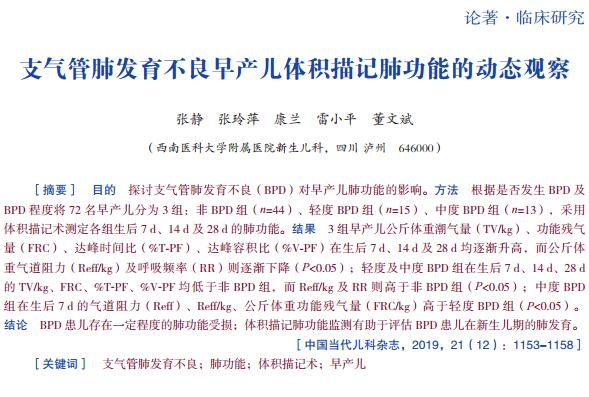 PDF(1196 KB)
PDF(1196 KB)


Dynamic observation of pulmonary function by plethysmography in preterm infants with bronchopulmonary dysplasia
ZHANG Jing, ZHANG Ling-Ping, KANG Lan, LEI Xiao-Ping, DONG Wen-Bin
Chinese Journal of Contemporary Pediatrics ›› 2019, Vol. 21 ›› Issue (12) : 1153-1158.
 PDF(1196 KB)
PDF(1196 KB)
 PDF(1196 KB)
PDF(1196 KB)
Dynamic observation of pulmonary function by plethysmography in preterm infants with bronchopulmonary dysplasia
Objective To study the effect of bronchopulmonary dysplasia (BPD) on lung function in preterm infants. Methods According to the presence/absence or the severity of BPD, 72 preterm infants were divided into non-BPD group (n=44), mild BPD group (n=15) and moderate BPD group (n=13). Lung function was assessed by plethysmography on days 7, 14 and 28 after birth. Results The preterm infants in the three groups had gradual increases in tidal volume per kilogram (TV/kg), functional residual capacity (FRC), ratio of time to peak tidal expiratory flow to total expiratory time (%T-PF) and ratio of volume to peak tidal expiratory flow to total expiratory volume (%V-PF) on days 7, 14 and 28 after birth, while there were gradual reductions in effective airway resistance per kilogram (Reff/kg) and respiratory rate (RR) (P < 0.05). Compared with the non-BPD group on days 7, 14 and 28 after birth, the mild and moderate BPD groups had significantly lower TV/kg, FRC,%T-PF, and%V-PF and significantly higher Reff/kg and RR (P < 0.05). On day 7 after birth, the moderate BPD group had significantly higher airway resistance, Reff/kg and FRC/kg than the mild BPD group (P < 0.05). Conclusions There is a certain degree of pulmonary function impairment in preterm infants with BPD. Dynamic monitoring of lung function by plethysmography is useful for assessing lung development in the neonatal period in these infants.

Bronchopulmonary dysplasia / Pulmonary function / Plethysmography / Preterm infant
[1] Jobe AH. Mechanisms of lung injury and bronchopulmonary dysplasia[J]. Am J Perinat, 2016, 33(11):1076-1078.
[2] Verheggen M, Wilson AC, Pillow JJ, et al. Respiratory function and symptoms in young preterm children in the contemporary era[J]. Pediatr Pulm, 2016, 51(12):1347-1355.
[3] Davidson LM, Berkelhamer SK. Bronchopulmonary dysplasia:chronic lung disease of infancy and long-term pulmonary outcomes[J]. J Clin Med, 2017, 6(1):pii:E4.
[4] Martinez FD. Early-life origins of chronic obstructive pulmonary disease[J]. N Engl J Med, 2016, 375(9):871-878.
[5] Cheong JLY, Doyle LW. An update on pulmonary and neurodevelopmental outcomes of bronchopulmonary dysplasia[J]. Semin Perinatol, 2018, 42(7):478-484.
[6] Lui K, Lloyd J, Ang E, et al. Early changes in respiratory compliance and resistance during the development of bronchopulmonary dysplasia in the era of surfactant therapy[J]. Pediatr Pulmonol, 2000, 30(4):282-290.
[7] Tortorolo L, Vento G, Matassa PG, et al. Early changes of pulmonary mechanics to predict the severity of bronchopulmonary dysplasia in ventilated preterm infants[J]. J Matern Fetal Neonatal Med, 2002, 12(5):332-337.
[8] May C, Kennedy C, Milner AD, et al. Lung function abnormalities in infants developing bronchopulmonary dysplasia[J]. Arch Dis Child, 2011, 96(11):1014-1019.
[9] Jobe AH, Bancalari E. Bronchopulmonary dysplasia[J]. Am J Respir Crit Care Med, 2001, 163(7):1723-1729.
[10] Frey U, Stocks J, Sly P, et al. Specification for signal processing and data handling used for infant pulmonary function testing. ERS/ATS Task Force on Standards for Infant Respiratory Function Testing. European Respiratory Society/American Thoracic Society[J]. Eur Respir J, 2000, 16(5):1016-1022.
[11] Kavvadia V, Greenough A, Dimitriou G. Early prediction of chronic oxygen dependency by lung function test results[J]. Pediatr Pulmonol, 2000, 29(1):19-26.
[12] Latzin P, Roth S, Thamrin C, et al. Lung volume, breathing pattern and ventilation inhomogeneity in preterm and term infants[J]. PLoS One, 2009, 4(2):e4635.
[13] 尹燕丹, 祁媛媛, 洪达, 等. 支气管肺发育不良早产儿1岁和2岁时体积描记肺功能的随访研究[J]. 中国循证儿科杂志, 2016, 11(5):352-356.
[14] Schmalisch G, Wilitzki S, Roehr CC, et al. Development of lung function in very low birth weight infants with or without bronchopulmonary dysplasia:longitudinal assessment during the first 15 months of corrected age[J]. BMC Pediatr, 2012, 12:37.
[15] Hilgendorff A, Reiss I, Gortner L, et al. Impact of airway obstruction on lung function in very preterm infants at term[J]. Pediatr Crit Care Med, 2008, 9(6):629-635.
[16] Fakhoury KF, Sellers C, Smith EO, et al. Serial measurements of lung function in a cohort of young children with bronchopulmonary dysplasia[J]. Pediatrics, 2010, 125(6):e1441-e1447.
[17] Godfrey S, Bar-Yishay E, Avital A, et al. What is the role of tests of lung function in the management of infants with lung disease?[J]. Pediatric Pulmonol, 2003, 36(1):1-9.
[18] 朱春梅, 陈慧中. 婴幼儿肺功能检测[J]. 中国医刊, 2009, 44(9):9-12.
[19] 王淑玉, 吕朝霞, 赵丽. 支气管肺发育不良患儿肺功能变化的动态随访研究[J]. 中国儿童保健杂志, 2015, 23(1):73-75.
[20] Fortuna M, Carraro S, Temporin E, et al. Mid-childhood lung function in a cohort of children with "new bronchopulmonary dysplasia"[J]. Pediatr Pulmonol, 2016, 51(10):1057-1064.
[21] Um-Bergström P, Hallberg J, Thunqvist P, et al. Lung function development after preterm birth in relation to severity of bronchopulmonary dysplasia[J]. BMC Pulm Med, 2017, 17(1):97.
[22] Caskey S, Gough A, Rowan S, et al. Structural and functional lung impairment in adult survivors of bronchopulmonary dysplasia[J]. Ann Am Thorac Soc, 2016, 13(8):1262-1270.
[23] 陈泽伟, 余加林, 刘晓红, 等. 支气管肺发育不良婴儿肺功能的初步研究[J]. 重庆医学, 2012, 41(29):3017-3019.